最新英语《We laughed a lot(说课稿)》教师招聘精品获奖完美优秀实用观摩课赛教课公开课示范优质课说课稿
小学英语《Module9 Unit1 We laughed a lot.》优质教案、教学设计
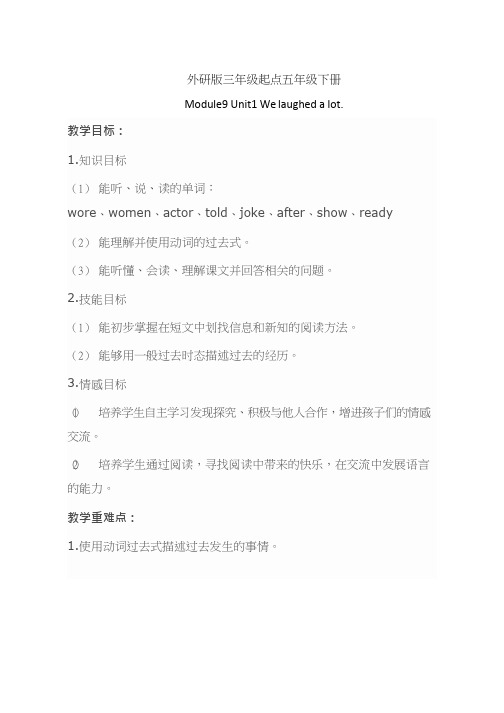
外研版三年级起点五年级下册Module9 Unit1 We laughed a lot.教学目标:1.知识目标(1)能听、说、读的单词:wore、women、actor、told、joke、after、show、ready(2)能理解并使用动词的过去式。
(3)能听懂、会读、理解课文并回答相关的问题。
2.技能目标(1)能初步掌握在短文中划找信息和新知的阅读方法。
(2)能够用一般过去时态描述过去的经历。
3.情感目标(1)培养学生自主学习发现探究、积极与他人合作,增进孩子们的情感交流。
(2)培养学生通过阅读,寻找阅读中带来的快乐,在交流中发展语言的能力。
教学重难点:1.使用动词过去式描述过去发生的事情。
教学过程Hello,boys and girls.I’m Sophy.Today I take some stickers for you.If you did a good job,you can get them. So come on and try your best! Ok? Let’s begin our class!Step1. Warming- up1. G reetings.T: Hello,boys and girls. Ss:Hello, Sophy.T :How are you,today ?Ss......2. H ave a free talk.Last week I went the Chishan Park. I walked along the lake.And I saw beautiful flowers and trees there.It was very funny. Now I want to know more about you.T:Where did you go ? Ss: I went to... T: What did you see there? Ss: I saw...Wow, it was very funny.Step2 .Leading-in1.Watch and answer:Boys and girls.I think all of you saw many funny things.What about our friends Sam,Amy and Linging?First,let’s watch and answer:What did they see? Please watch carefully! What did they see?Now have a match. What did Amy see? A 、B or C. Who can answer?(1) Yes,she saw a dog. It wore a coat.(同时学习“wore ”)(2) What about Sam? That’s right.(3) And Lingling …Yes,she saw a man.It wore a skirt.It was very funny. 2.Another man.Let’s see another funny man.Look!Who’ this? Ss: Deng Chao. He wore a2. 听、说、读并正确使用单词:wore 、women 、actor 、told 、joke 、after 、show 、ready 以及这些单词的呈现。
Module 9 Unit 1 We laughed a lot (说课稿)-2022-2023学年
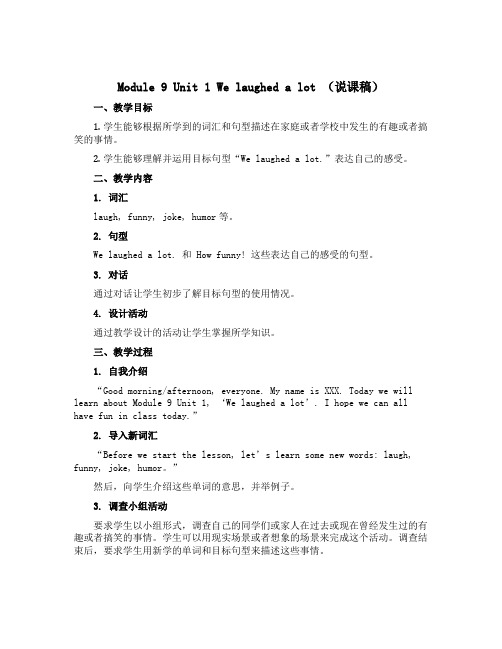
Module 9 Unit 1 We laughed a lot (说课稿)一、教学目标1.学生能够根据所学到的词汇和句型描述在家庭或者学校中发生的有趣或者搞笑的事情。
2.学生能够理解并运用目标句型“We laughed a lot.”表达自己的感受。
二、教学内容1. 词汇laugh, funny, joke, humor等。
2. 句型We laughed a lot. 和 How funny! 这些表达自己的感受的句型。
3. 对话通过对话让学生初步了解目标句型的使用情况。
4. 设计活动通过教学设计的活动让学生掌握所学知识。
三、教学过程1. 自我介绍“Good morning/afternoon, everyone. My name is XXX. Today we will learn about Module 9 Unit 1, ‘We laughed a lot’. I hope we can all have fun in class today.”2. 导入新词汇“Before we start the lesson, let’s learn some new word s: laugh, funny, joke, humor。
”然后,向学生介绍这些单词的意思,并举例子。
3. 调查小组活动要求学生以小组形式,调查自己的同学们或家人在过去或现在曾经发生过的有趣或者搞笑的事情。
学生可以用现实场景或者想象的场景来完成这个活动。
调查结束后,要求学生用新学的单词和目标句型来描述这些事情。
4. 观看相关的视频在教学过程中,通过播放和观看相关的视频带领学生进入到正式的学习环节。
可以根据实际情况选择一些带有趣味性的视频进行播放,以吸引学生的注意力。
5. 制作卡片在完成以上几个活动后,可以把学生分成几组,然后要求学生以小组形式制作卡片。
卡片上可以写下一些有趣或者搞笑的事情,并在卡片上加上相应的图片或者漫画。
小学英语《Module 9 Unit 1 We laughed a lot》优质教案、教学设计
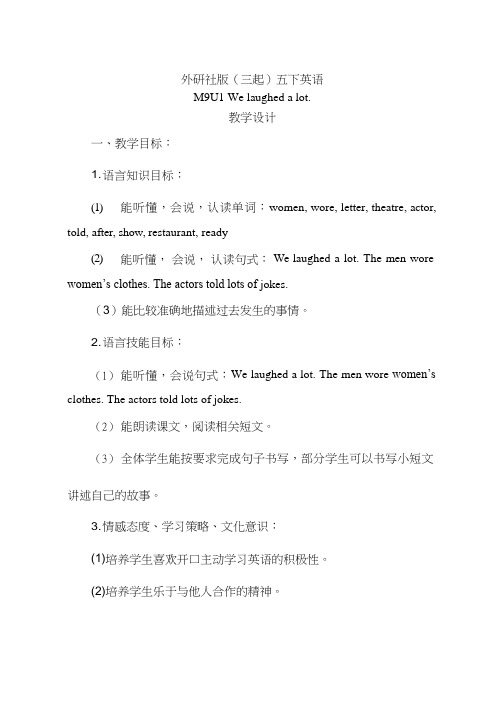
外研社版(三起)五下英语M9U1 We laughed a lot.教学设计一、教学目标:1. 语言知识目标:(1)能听懂,会说,认读单词:women, wore, letter, theatre, actor, told, after, show, restaurant, ready(2)能听懂,会说,认读句式:We laughed a lot. The men wore women’s clothes. The actors told lots of jokes.(3)能比较准确地描述过去发生的事情。
2. 语言技能目标:(1)能听懂,会说句式:We laughed a lot. The men wore women’s clothes. The actors told lots of jokes.(2)能朗读课文,阅读相关短文。
(3)全体学生能按要求完成句子书写,部分学生可以书写小短文讲述自己的故事。
3. 情感态度、学习策略、文化意识:(1)培养学生喜欢开口主动学习英语的积极性。
(2)培养学生乐于与他人合作的精神。
(3) 热爱生活,积极进取的乐观情绪。
(4) 对所学内容能主动复习和归纳;积极运用动词的过去式跟同伴讲述自己的经历。
(5) 在学习和日常交际中,能进一步注意到中外文化的异同。
二、教学重难点:1. 教学重点:(1) 能听懂,会说,认读单词:women, wore, letter, theatre, actor, told, after, show, restaurant, ready(2) 能听懂,会说,认读句式: We laughed a lot. The men wore women’s clothes. The actors told lots of jokes.(3) 能比较准确地描述过去发生的事情。
2. 教学难点:(1) 能借助图片和文字听懂、读懂和朗读课文。
(2)能够正确使用过去式描述过去发生的事情。
Module 9 Unit 1 We laughed a lot.(教案)-2022-2023学年英

Module 9 Unit 1 We laughed a lot教案知识目标1.能听懂、会说、会读、会写生词:joke,laugh。
2.能听懂、会说、会读句型:What’s so funny?It’s a joke. We laugheda lot.。
3.能够通过听、说、读、写等方式来讲述笑话。
能力目标1.能够通过观察、理解和模仿来学习英语交际;2.通过活动的形式培养学生的语音、语调和说话的流利度;3.培养学生探究新事物、富有好奇心和探究能力;4.培养学生的团队合作意识和互帮互助的精神。
情感目标1.意识到幽默的力量,懂得欣赏、表达与分享幽默;2.培养学生爱好英语的能力。
教学重点1.生词的认读和听、说、读、写;2.句型What’s so funny?It’s a joke. We laughed a lot.。
教学难点通过活动的形式培养学生的说话流利度。
教学准备PPT,图片,笑话卡片。
活动设计活动一:导入1.教师引导学生学习两个生词:joke,laugh,并巩固单词的发音和意思。
2.教师播放一段小视频,然后问学生观看视频有什么感觉,为什么会觉得好笑。
视频内容可以是某些表情或动作比较有趣味的动物,比如黑猩猩,海豹等等。
活动二:呈现1.教师播放一个短笑话卡片,然后让学生看看,然后说一下这个笑话为什么好笑。
2.以小组为单位,每组派出一名同学来表演自己的笑话。
同学可以在课前准备好或现场想出来,让全班同学观看表演,然后评选出一组比较好的笑话。
活动三:总结1.教师让学生说一下都听到了哪些和笑话有关的句子,然后在PPT上呈现句型What’s so funny?It’s a joke. We laugh ed a lot.。
2.教师让学生读一遍句型,然后进行简单的角色扮演,让学生分成两组,轮流问和回答这三个句子。
课后作业写一篇日记,描述一件有趣的事情,并加入英语笑话句型。
Module 9 Unit 1 We laughed a lot(说课稿)-2022-2023学年英
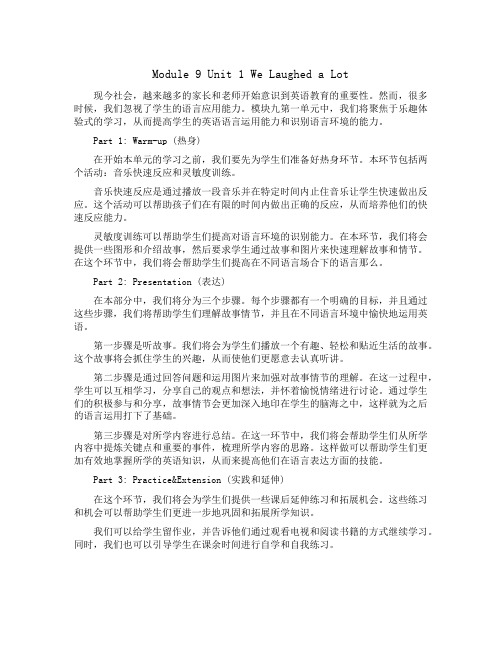
Module 9 Unit 1 We Laughed a Lot现今社会,越来越多的家长和老师开始意识到英语教育的重要性。
然而,很多时候,我们忽视了学生的语言应用能力。
模块九第一单元中,我们将聚焦于乐趣体验式的学习,从而提高学生的英语语言运用能力和识别语言环境的能力。
Part 1: Warm-up (热身)在开始本单元的学习之前,我们要先为学生们准备好热身环节。
本环节包括两个活动:音乐快速反应和灵敏度训练。
音乐快速反应是通过播放一段音乐并在特定时间内止住音乐让学生快速做出反应。
这个活动可以帮助孩子们在有限的时间内做出正确的反应,从而培养他们的快速反应能力。
灵敏度训练可以帮助学生们提高对语言环境的识别能力。
在本环节,我们将会提供一些图形和介绍故事,然后要求学生通过故事和图片来快速理解故事和情节。
在这个环节中,我们将会帮助学生们提高在不同语言场合下的语言那么。
Part 2: Presentation (表达)在本部分中,我们将分为三个步骤。
每个步骤都有一个明确的目标,并且通过这些步骤,我们将帮助学生们理解故事情节,并且在不同语言环境中愉快地运用英语。
第一步骤是听故事。
我们将会为学生们播放一个有趣、轻松和贴近生活的故事。
这个故事将会抓住学生的兴趣,从而使他们更愿意去认真听讲。
第二步骤是通过回答问题和运用图片来加强对故事情节的理解。
在这一过程中,学生可以互相学习,分享自己的观点和想法,并怀着愉悦情绪进行讨论。
通过学生们的积极参与和分享,故事情节会更加深入地印在学生的脑海之中,这样就为之后的语言运用打下了基础。
第三步骤是对所学内容进行总结。
在这一环节中,我们将会帮助学生们从所学内容中提炼关键点和重要的事件,梳理所学内容的思路。
这样做可以帮助学生们更加有效地掌握所学的英语知识,从而来提高他们在语言表达方面的技能。
Part 3: Practice&Extension (实践和延伸)在这个环节,我们将会为学生们提供一些课后延伸练习和拓展机会。
小学英语《1We laughed a lot》优质课教学设计、教案
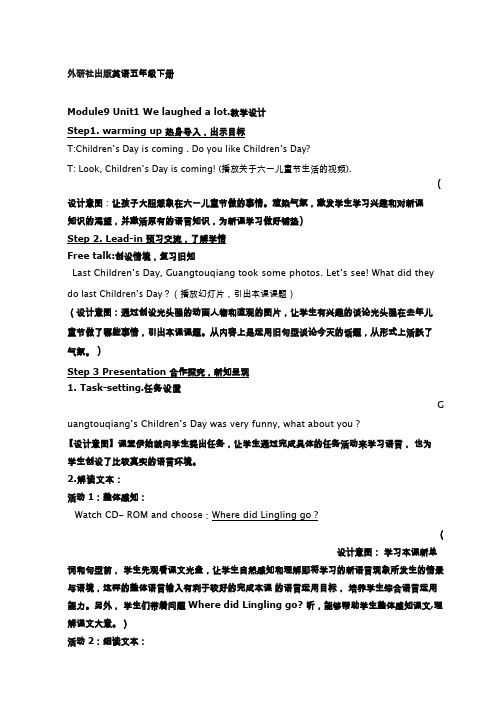
外研社出版英语五年级下册Module9 Unit1 We laughed a lot.教学设计Step1. warming up 热身导入,出示目标T:Children’s Day is coming . Do you like Children’s Day?T: Look, Children’s Day is coming! (播放关于六一儿童节生活的视频).(设计意图:让孩子大胆想象在六一儿童节做的事情。
渲染气氛,激发学生学习兴趣和对新课知识的渴望,并激活原有的语言知识,为新课学习做好铺垫)Step 2. Lead-in 预习交流,了解学情Free talk:创设情境,复习旧知Last Children’s Day, Guangtouqiang took some photos. Let’s see! What did they do last Children’s Day?(播放幻灯片,引出本课课题)(设计意图:通过创设光头强的动画人物和直观的图片,让学生有兴趣的谈论光头强在去年儿童节做了哪些事情,引出本课课题。
从内容上是运用旧句型谈论今天的话题,从形式上活跃了气氛。
)Step 3 Presentation 合作探究,新知呈现1.Task-setting.任务设置G uangtouqiang’s Children’s Day was very funny, what about you ?【设计意图】课堂伊始就向学生提出任务,让学生通过完成具体的任务活动来学习语言,也为学生创设了比较真实的语言环境。
2.解读文本:活动1:整体感知:Watch CD- ROM and choose:Where did Lingling go ?(设计意图:学习本课新单词和句型前,学生先观看课文光盘,让学生自然感知和理解即将学习的新语言现象所发生的情景与语境,这样的整体语言输入有利于较好的完成本课的语言运用目标,培养学生综合语言运用能力。
Module9Unit1Welaughedalot的说课稿
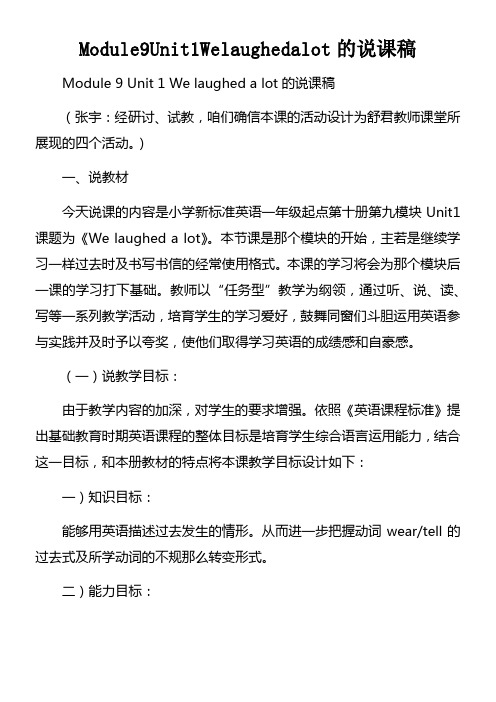
活动一:单词对对碰(滚雪球)
教学预备:课前教师为每组学生预备一张动词过去式的图表
教学进程:如此一张表格,给动词原型,让学生写动词过去式;或给动词过去式,让学生写原型,反复操练,让学生依次传递些,每人写2个,对书写有困难的同窗能够组内协作完成,分组竞赛,看哪组写得又快,准确率又高。紧接着教师让学生用这些动词过去式来讲句子,像滚雪球一样,哪组接不上,就淘汰,最后一组为冠军。也为下一个活动作好铺垫。
第二环节:然后很自然地过渡到课文的学习。完成Part1学生看书听录音,小组合作回答下列问题,并跟录音朗诵。师给出问题:让学生带着任务听录音,并回答下列问题。既锻炼了学生听的能力,有训练了学生说的能力。
第三环节:再听录音,加深印象。在那个地址教师设置了让学生快速找到动词过去式,看谁找得快、多、准。这一教学不仅训练了学生的反映能力,而且还对动词过去是进行了一个简短的小温习,在学习进程中,教师多鼓舞、夸奖学生,树立学生学习的信心,激发了踊跃性。
第四环节:完成Part2 Listen and say. 请学生看图听录音,然后在小组里分角色对话,最后给全班演出。这一环节,同窗们合作完成对话,为后面的演出作了铺垫,并成心识地拉近知识与生活的距离,使学生的语言知识取得实际应用。
Step3.Practice 趣味操练,联系旧知,巩固新知——操练环节
Module9 Unit1 We laughed a lot
What did you do last night?
I ……last night.
Step2 Presentation 引入新知,层层冲破——新授环节
招聘英语教师招聘面试《We-laughed-a-lot》教案
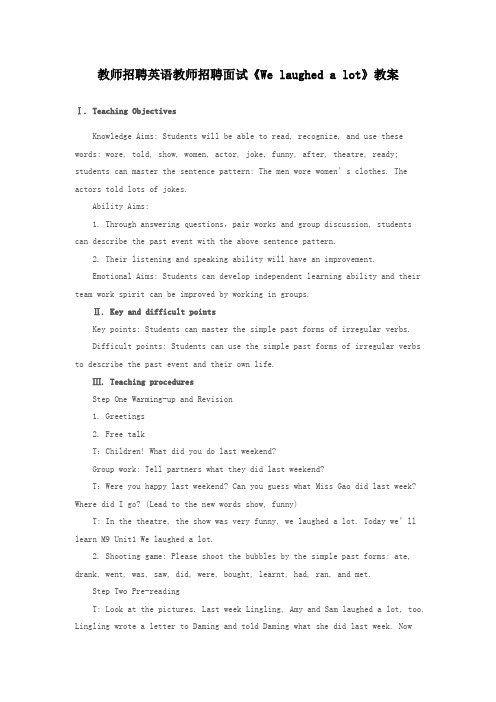
教师招聘英语教师招聘面试《We laughed a lot》教案Ⅰ. Teaching ObjectivesKnowledge Aims: Students will be able to read, recognize, and use these words: wore, told, show, women, actor, joke, funny, after, theatre, ready; students can master the sentence pattern: The men wore women’s clothes. The actors told lots of jokes.Ability Aims:1. Through answering questions,pair works and group discussion, students can describe the past event with the above sentence pattern.2. Their listening and speaking ability will have an improvement.Emotional Aims: Students can develop independent learning ability and their team work spirit can be improved by working in groups.Ⅱ. Key and difficult pointsKey points: Students can master the simple past forms of irregular verbs.Difficult points: Students can use the simple past forms of irregular verbs to describe the past event and their own life.Ⅲ. Teaching proceduresStep One Warming-up and Revision1. Greetings2. Free talkT:Children! What did you do last weekend?Group work: Tell partners what they did last weekend?T:Were you happy last weekend? Can you guess what Miss Gao did last week? Where did I go? (Lead to the new words show, funny)T: In the theatre, the show was very funny, we laughed a lot. Today we’ll learn M9 Unit1 We laughed a lot.2. Shooting game: Please shoot the bubbles by the simple past forms: ate, drank, went, was, saw, did, were, bought, learnt, had, ran, and met.Step Two Pre-readingT: Look at the pictures. Last week Lingling, Amy and Sam laughed a lot, too. Lingling wrote a letter to Daming and told Daming what she did last week. Nowlet’s look at the letter. Please enjoy it and find the verbs in the past tense. Let’s listen to the tape carefully.T: Listen again and find the new words.Step Three While-readingT: Listen and read the first paragraph and answer questions:1. Where did they go last week?2. Who were in the children’s theatre?Lead to the new forms men, women, and actor.(a man two men a woman two women)3. What did they do?What did the men do? ----- The men wore women’s clothesWhat did the women do? ---- The women wore men’s clothesWhat did the actors do? --- The actors told lots of jokesWhat did the children do? --They laughed a lotT: Repeat the first paragraph and pay attention to the pronunciation.T: Reading the second paragraph and answer the following questions.After the show where did Lingling go? And what did they eat?T: Do you like eating hamburgers and chips?T: But be careful! Don’t eat too much. It’s not good for you! If you eat too much, you will be fatter and fatter.Repeat the second paragraph.Read the letter and find the answers1. Who wrote this letter?2. Where did Lingling live?3. Who did Lingling write this letter to?4. Where is Daming going to go? (Daming is ready for a trip to America. Heis very happy.)5. How many letters does Daming have got? Where were they from?Read after the tapeStep Four:Post-reading1. Describe what Tom did according to the pictures.2. Group work. Some students describe the pictures and the others guess the picture.Step Five Summary and HomeworkT: who can tell us what we have learnt today.T: I hope you can write a short composition about what you did last summer vacation. Next class I will invite some students share their work with us.Blackboard design。
小学英语《welaughedalot》教案
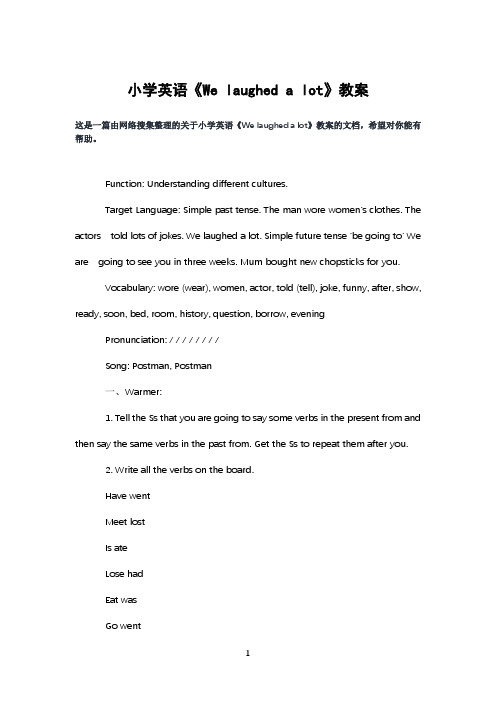
小学英语《We laughed a lot》教案这是一篇由网络搜集整理的关于小学英语《We laughed a lot》教案的文档,希望对你能有帮助。
Function: Understanding different cultures.Target Language: Simple past tense. The man wore women's clothes. The actors told lots of jokes. We laughed a lot. Simple future tense 'be going to' We are going to see you in three weeks. Mum bought new chopsticks for you.Vocabulary: wore (wear), women, actor, told (tell), joke, funny, after, show, ready, soon, bed, room, history, question, borrow, eveningPronunciation: / / / / / / / /Song: Postman, Postman一、Warmer:1. Tell the Ss that you are going to say some verbs in the present from and then say the same verbs in the past from. Get the Ss to repeat them after you.2. Write all the verbs on the board.Have wentMeet lostIs ateLose hadEat wasGo went3. Get the Ss to work in pairs. One student says the verb in the present tense from and the other says the verb in the past form.二、Presentation:1. Look, listen and learn:A. Listen to the tape and underline the verbs in past tense form. (went, wore,told, laughed, women, actor, joke, funny, after, show, ready)B. Play the dialogue again and answer the questions:1) Where did Lingling go last week?2) What did the men and the women wear?3) What did the actors do?4) Where did they go after the show?5) What did they eat?C. Listen to the text and complete?Dear Daming:Last week we went to a children's theatre . The man wore women's clothes . The women wore men's clothes. The actors told lots of jokes . It was very funny.We laughed a lot. English children love the theatre.After the show we went to a restaurant. We all ate hamburgers and chips.Are you ready for your trip to America?From,Lingling2. Look and say.A. Ask and answer: What did he do last night?He watched TV.He played computer games.He ate an apple/ sweets.He played toys.He drank some milk.He read books.三、Activity book:Listen and write some sentences:1) Xiaoyong went to a party yesterday.2) He wore a beautiful sweater.3) He said 'Happy birthday' to his friend.4) His friend gave him a birthday hat.5) They played games together happily.6) They ate a big birthday cake.7) They were very happy.四、Homework:1. Read the text.2. Remember the new words. /。
We laughed a lot说课稿
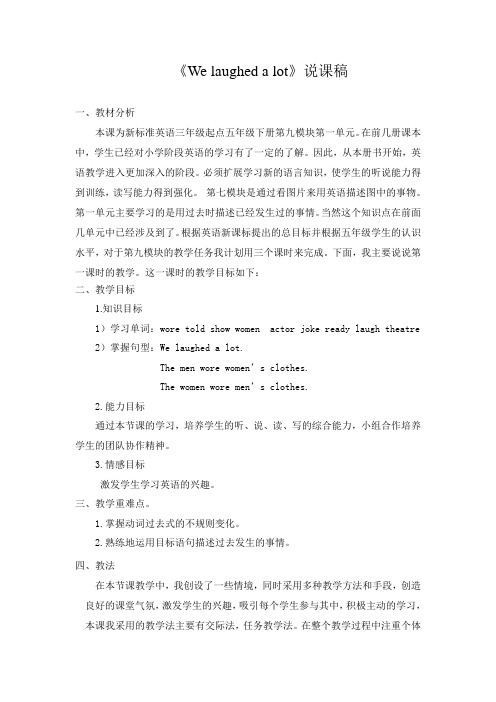
《We laughed a lot》说课稿一、教材分析本课为新标准英语三年级起点五年级下册第九模块第一单元。
在前几册课本中,学生已经对小学阶段英语的学习有了一定的了解。
因此,从本册书开始,英语教学进入更加深入的阶段。
必须扩展学习新的语言知识,使学生的听说能力得到训练,读写能力得到强化。
第七模块是通过看图片来用英语描述图中的事物。
第一单元主要学习的是用过去时描述已经发生过的事情。
当然这个知识点在前面几单元中已经涉及到了。
根据英语新课标提出的总目标并根据五年级学生的认识水平,对于第九模块的教学任务我计划用三个课时来完成。
下面,我主要说说第一课时的教学。
这一课时的教学目标如下:二、教学目标1.知识目标1)学习单词:wore told show women actor joke ready laugh theatre 2)掌握句型:We laughed a lot.The men wore women’s clothes.The women wore men’s clothes.2.能力目标通过本节课的学习,培养学生的听、说、读、写的综合能力,小组合作培养学生的团队协作精神。
3.情感目标激发学生学习英语的兴趣。
三、教学重难点。
1.掌握动词过去式的不规则变化。
2.熟练地运用目标语句描述过去发生的事情。
四、教法在本节课教学中,我创设了一些情境,同时采用多种教学方法和手段,创造良好的课堂气氛,激发学生的兴趣,吸引每个学生参与其中,积极主动的学习,本课我采用的教学法主要有交际法,任务教学法。
在整个教学过程中注重个体发展和群体提高。
对于一些学习能力比较差的学生,鼓励他们开口,勤于思考;对于学习能力比较强的学生,引导他们学会合作和交流,养成善于争鸣、勇于创新的科学态度,使各类学生通过这节课的听说活动,都有所收获、提高和发展。
五、教学过程。
1.Warm up.(课前热身)1)Greeting.2)Chant《Up and down》(设计意图:通过热身调动学生的学习积极性)2.Have a revision.(复习动词过去式)do——did laugh——laugheddance——danced are——wereeat——ate wear——woremeet——met tell——told(设计意图:通过复习,为新课奠定基础)1.Presentation and lead in.(呈现与导入)1)Show some pictures and ask:What did they do2)Lingling and Amy went to the theatre. Do you want to know what they saw? Let’s together.4.New teaching.(新课学习)1)Read the new words.(Ask some students to read lead in)2)Learn some important sentences.e.g. a children’s theatre(儿童剧院)The show was very funny.The men wore women’s clothes.The women wore men’s clothes.4.Listen to the audio and think about the following questions.a.Where did lingling go last week?b.What did the men and women wear?c.What did the actors do?d.What did they do after the show?e.What did they eat?(设计意图:通过思考问题,培养学生的阅读能力)4)Read and explain the text.5)Ask some students to read the text.5.Practise.(巩固与练习)1)Fill in the blacks.2) Look, ask and answer.(设计意图:通过练习,巩固今天所学)四、Homework.1.read the text.2.Write a letter to your friend who in not in the same school with you.。
Module 9 Unit 1 We laughed a lot.(说课稿)-2022-2023学年
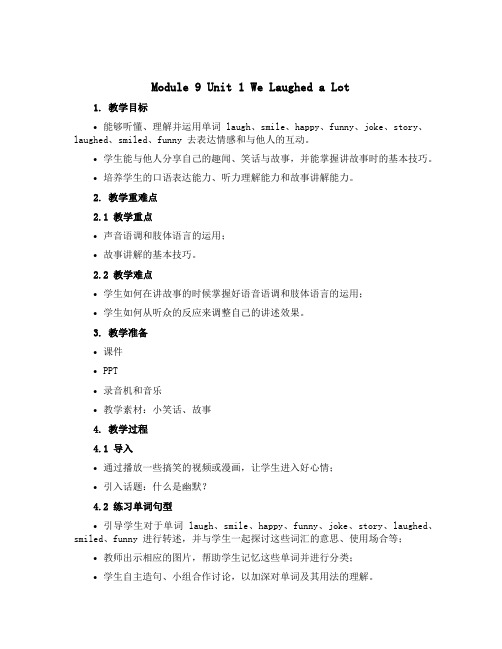
Module 9 Unit 1 We Laughed a Lot1. 教学目标•能够听懂、理解并运用单词 laugh、smile、happy、funny、joke、story、laughed、smiled、funny 去表达情感和与他人的互动。
•学生能与他人分享自己的趣闻、笑话与故事,并能掌握讲故事时的基本技巧。
•培养学生的口语表达能力、听力理解能力和故事讲解能力。
2. 教学重难点2.1 教学重点•声音语调和肢体语言的运用;•故事讲解的基本技巧。
2.2 教学难点•学生如何在讲故事的时候掌握好语音语调和肢体语言的运用;•学生如何从听众的反应来调整自己的讲述效果。
3. 教学准备•课件•PPT•录音机和音乐•教学素材:小笑话、故事4. 教学过程4.1 导入•通过播放一些搞笑的视频或漫画,让学生进入好心情;•引入话题:什么是幽默?4.2 练习单词句型•引导学生对于单词 laugh、smile、happy、funny、joke、story、laughed、smiled、funny 进行转述,并与学生一起探讨这些词汇的意思、使用场合等;•教师出示相应的图片,帮助学生记忆这些单词并进行分类;•学生自主造句、小组合作讨论,以加深对单词及其用法的理解。
4.3 练习讲故事•教师介绍关于如何给别人讲故事的基本技巧,比如掌握声音语调、肢体语言等,以及如何在讲述过程中寻找听众的反应,并根据反应情况来调整自己的讲述效果;•分组将学生分成故事讲述人和故事听者两个角色,在组内进行小组讲述;•每个小组回顾、分享自己的体验和掌握的技巧;•教师在学生讲述时给予一定的指导和点评。
4.4 提高练习•组织学生自己编写笑话或趣闻,并进行相互讲述;•教师给予指导和点评,评判学生的表达能力和讲述技巧。
4.5 小结•教师总结本节课的重点内容;•学生进行自我检查、小结。
5. 课堂作业•搜集趣闻笑话,准备第二节课的故事分享。
6. 教学反思•学生对于词汇掌握欠缺,需要运用更多有趣、生动多彩的教学方式,如义务上台演示、齐诵等;•教师在听学生讲述时,需要及时给予反馈,有效地指引学生的表达方向,促进学生更好地掌握故事的讲述技巧。
Module 9 Unit 1 We laughed a lot (说课稿)-2022-2023学年
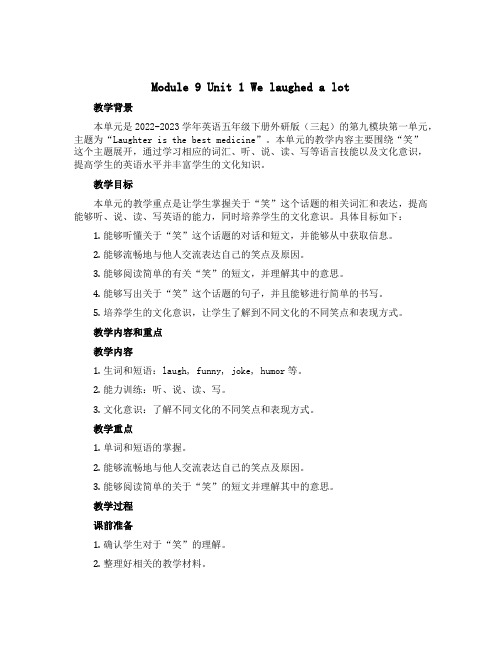
Module 9 Unit 1 We laughed a lot教学背景本单元是2022-2023学年英语五年级下册外研版(三起)的第九模块第一单元,主题为“Laughter is the best medicine”。
本单元的教学内容主要围绕“笑”这个主题展开,通过学习相应的词汇、听、说、读、写等语言技能以及文化意识,提高学生的英语水平并丰富学生的文化知识。
教学目标本单元的教学重点是让学生掌握关于“笑”这个话题的相关词汇和表达,提高能够听、说、读、写英语的能力,同时培养学生的文化意识。
具体目标如下:1.能够听懂关于“笑”这个话题的对话和短文,并能够从中获取信息。
2.能够流畅地与他人交流表达自己的笑点及原因。
3.能够阅读简单的有关“笑”的短文,并理解其中的意思。
4.能够写出关于“笑”这个话题的句子,并且能够进行简单的书写。
5.培养学生的文化意识,让学生了解到不同文化的不同笑点和表现方式。
教学内容和重点教学内容1.生词和短语:laugh, funny, joke, humor等。
2.能力训练:听、说、读、写。
3.文化意识:了解不同文化的不同笑点和表现方式。
教学重点1.单词和短语的掌握。
2.能够流畅地与他人交流表达自己的笑点及原因。
3.能够阅读简单的关于“笑”的短文并理解其中的意思。
教学过程课前准备1.确认学生对于“笑”的理解。
2.整理好相关的教学材料。
主要教学环节Step 1:Lead-in1.Play a short video about making people laugh.2.Ask students some questions about the video:–What happened in the video?–Did you enjoy it?–Do you think making people laugh is important? Why or why not?Step 2:Vocabulary and phrases1.Introduce the new vocabulary and phrases:–laugh–funny–joke–humor2.Ask students to repeat each word after the teacher and encourage them to use the words in sentences.Step 3:Listening1.Listen to a conversation about jokes.2.Ask students to answer the questions about the conversation.–What do they think is funny?–What is their favorite joke?Step 4:Speaking1.Ask students to turn to a partner and share their favorite joke.2.Encourage students to ask questions and laugh together.Step 5:Reading1.Read a short passage about different types of humor.2.Ask students to answer the questions about the passage.–What are some different types of humor that people enjoy?–What is your favorite type of humor?Step 6:Writing1.Ask students to write a sentence about their favorite joke.2.Encourage students to share their sentences with the class.Step 7:Cultural Awareness1.Show students some pictures or videos of comedians from different countries.2.Ask students to discuss the differences and similarities in the comedians’ humor.课后作业1.Ask students to write a short paragraph about their favorite type of humor.2.Encourage students to share their paragraphs with their classmates.教学评价本节课主要通过引导学生了解“笑”的话题,帮助学生掌握关于“笑”这个话题的相关词汇和表达,提高能够听、说、读、写英语的能力,培养学生的文化意识。
Module 9《We laughed a lot》优秀教案
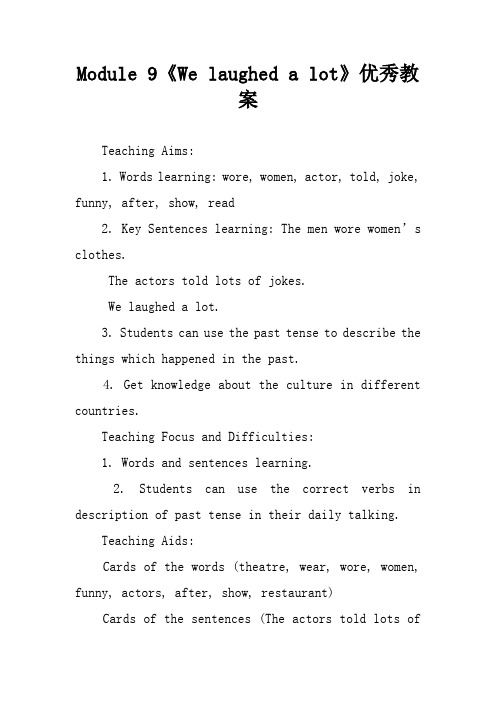
Module 9《We laughed a lot》优秀教案Teaching Aims:1. Words learning: wore, women, actor, told, joke, funny, after, show, read2. Key Sentences learning: The men wore women’s clothes.The actors told lots of jokes.We laughed a lot.3. Students can use the past tense to describe the things which happened in the past.4. Get knowledge about the culture in different countries.Teaching Focus and Difficulties:1. Words and sentences learning.2. Students can use the correct verbs in description of past tense in their daily talking.Teaching Aids:Cards of the words (theatre, wear, wore, women, funny, actors, after, show, restaurant)Cards of the sentences (The actors told lots ofjokes/ The men wore women’s clothes/ We laughed a lot.) Course ware of this unit.Teaching Steps:Step 1 Warmer:Ask students to say the past tense of the following words in order to review the past tense of the words they’ve learnt. Meanwhile it can help them to learn the text and do the activity 3 easily.E.g. look-looked/ play-played/ do-did/ is-was/ go-went/ eat-ate/ drink-drank…(在热身环节通过对单词过去式的复习,很好的让同学复习了规则和不规则的过去式形式,为课文的教授,尤其是对活动三的练习做了很好的铺垫)Step 2 Presentation1. Set a similar environment as the passage, teach the new words during the course of ask and answer.T: “Last week, I went to a theatre. Do you want to know what I saw?Ok, let’s go and see it”Ask students to look at the pictures and answer the question1) What did the man wear? →The men wore the women’s clothes.2) Who are they? →They are actors.3) What did the actors do? →The actors told lots of jokes.4) Was it funny? →Yes, it was funny.5) Do you love the theatre?(创设真实的剧院情境,让同学很容易从中学到相关的重点单词和句型。
Module 9 Unit 1 We laughed a lot第1课时(说课稿)-2022-202
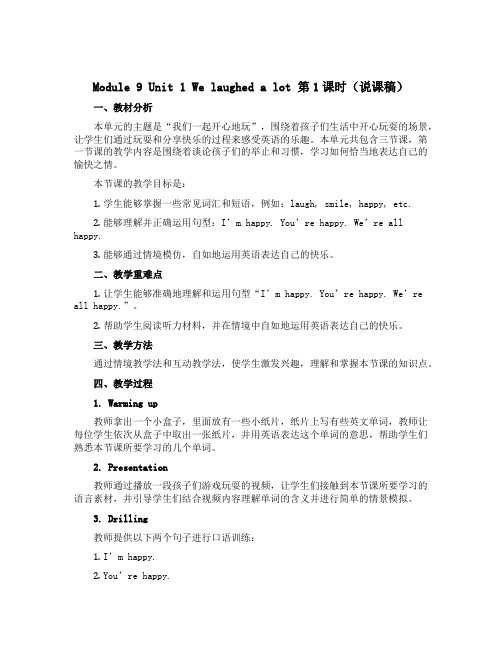
Module 9 Unit 1 We laughed a lot 第1课时(说课稿)一、教材分析本单元的主题是“我们一起开心地玩”,围绕着孩子们生活中开心玩耍的场景,让学生们通过玩耍和分享快乐的过程来感受英语的乐趣。
本单元共包含三节课,第一节课的教学内容是围绕着谈论孩子们的举止和习惯,学习如何恰当地表达自己的愉快之情。
本节课的教学目标是:1.学生能够掌握一些常见词汇和短语,例如:laugh, smile, happy, etc.2.能够理解并正确运用句型:I’m happy. You’re happy.We’re all happy.3.能够通过情境模仿,自如地运用英语表达自己的快乐。
二、教学重难点1.让学生能够准确地理解和运用句型“I’m happy. You’re happy. We’re all happy.”。
2.帮助学生阅读听力材料,并在情境中自如地运用英语表达自己的快乐。
三、教学方法通过情境教学法和互动教学法,使学生激发兴趣,理解和掌握本节课的知识点。
四、教学过程1. Warming up教师拿出一个小盒子,里面放有一些小纸片,纸片上写有些英文单词,教师让每位学生依次从盒子中取出一张纸片,并用英语表达这个单词的意思,帮助学生们熟悉本节课所要学习的几个单词。
2. Presentation教师通过播放一段孩子们游戏玩耍的视频,让学生们接触到本节课所要学习的语言素材,并引导学生们结合视频内容理解单词的含义并进行简单的情景模拟。
3. Drilling教师提供以下两个句子进行口语训练:1.I’m happy.2.You’re happy.教师通过对这两个句子的带头模仿和模拟,引导学生跟读,并反复练习这两个句子,使学生掌握句型的用法和语调。
4. Consolidation教师让学生们参与到一个小游戏中,指导他们运用本节课所学的语言素材互相回答有关自己快乐的事情。
例如:What makes you happy? What do you like to do for fun? 等等。
Unit 1 We laughed a lot【优质教案】.doc
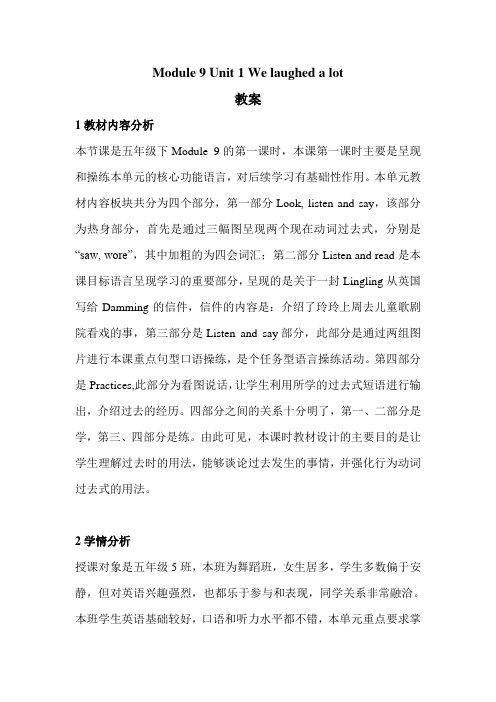
Module 9 Unit 1 We laughed a lot教案1教材内容分析本节课是五年级下Module 9的第一课时,本课第一课时主要是呈现和操练本单元的核心功能语言,对后续学习有基础性作用。
本单元教材内容板块共分为四个部分,第一部分Look, listen and say,该部分为热身部分,首先是通过三幅图呈现两个现在动词过去式,分别是“saw, wore”,其中加粗的为四会词汇;第二部分Listen and read是本课目标语言呈现学习的重要部分,呈现的是关于一封Lingling从英国写给Damming的信件,信件的内容是:介绍了玲玲上周去儿童歌剧院看戏的事,第三部分是Listen and say部分,此部分是通过两组图片进行本课重点句型口语操练,是个任务型语言操练活动。
第四部分是Practices,此部分为看图说话,让学生利用所学的过去式短语进行输出,介绍过去的经历。
四部分之间的关系十分明了,第一、二部分是学,第三、四部分是练。
由此可见,本课时教材设计的主要目的是让学生理解过去时的用法,能够谈论过去发生的事情,并强化行为动词过去式的用法。
2学情分析授课对象是五年级5班,本班为舞蹈班,女生居多,学生多数偏于安静,但对英语兴趣强烈,也都乐于参与和表现,同学关系非常融洽。
本班学生英语基础较好,口语和听力水平都不错,本单元重点要求掌握十二个单词,两个短语,但其中多为生词,多数学生未接触过,需要通过一定的情境和训练让学生理解、掌握。
过去时句型结构、动词过去式对学生来说是并不是新的语法,只需强化个别新词的过去式用法即可。
3教学目标1.知识目标:(1)能听说认读单词:wore, women, told, after, show, theatre, joke restaurant, letter, actor,ready,laugh.(2)熟记重点短语:tell a joke, be ready for(3)掌握重点句型:①The men wore women’s clothes.②The actors told lots of jokes.③We laughed a lot.(4)能听懂、会读、理解课文并回答相关的问题。
新标准英语五级下册说课稿 unit 1 We laughed a lot【推荐下载】
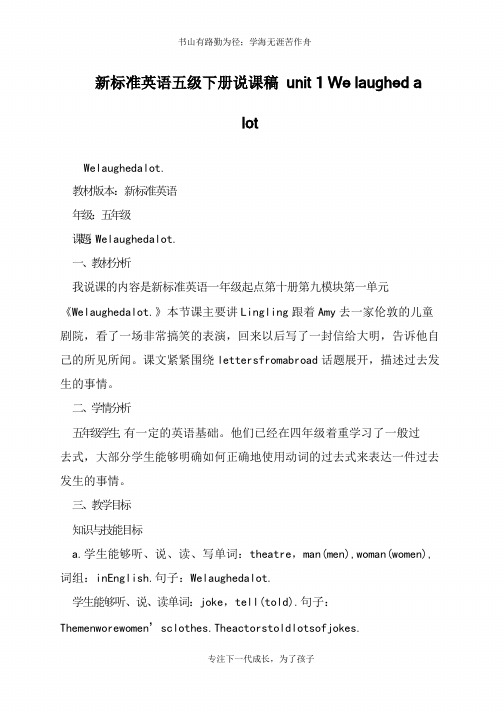
书山有路勤为径;学海无涯苦作舟
新标准英语五级下册说课稿unit 1 We laughed a
lot
Welaughedalot.
教材版本:新标准英语
年级:五年级
课题:Welaughedalot.
一、教材分析
我说课的内容是新标准英语一年级起点第十册第九模块第一单元《Welaughedalot.》本节课主要讲Lingling跟着Amy去一家伦敦的儿童剧院,看了一场非常搞笑的表演,回来以后写了一封信给大明,告诉他自己的所见所闻。
课文紧紧围绕lettersfromabroad话题展开,描述过去发生的事情。
二、学情分析
五年级学生,有一定的英语基础。
他们已经在四年级着重学习了一般过
去式,大部分学生能够明确如何正确地使用动词的过去式来表达一件过去发生的事情。
三、教学目标
知识与技能目标
a.学生能够听、说、读、写单词:theatre,man(men),woman(women), 词组:inEnglish.句子:Welaughedalot.
学生能够听、说、读单词:joke,tell(told).句子:Themenworewomen’sclothes.Theactorstoldlotsofjokes.
专注下一代成长,为了孩子。
Module 9 Unit 1 We laughed a lot.(说课稿)-2022-2023学年
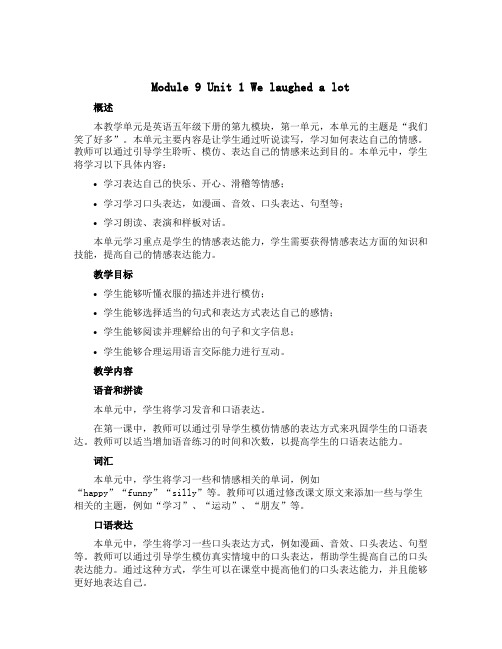
Module 9 Unit 1 We laughed a lot概述本教学单元是英语五年级下册的第九模块,第一单元,本单元的主题是“我们笑了好多”。
本单元主要内容是让学生通过听说读写,学习如何表达自己的情感。
教师可以通过引导学生聆听、模仿、表达自己的情感来达到目的。
本单元中,学生将学习以下具体内容:•学习表达自己的快乐、开心、滑稽等情感;•学习学习口头表达,如漫画、音效、口头表达、句型等;•学习朗读、表演和样板对话。
本单元学习重点是学生的情感表达能力,学生需要获得情感表达方面的知识和技能,提高自己的情感表达能力。
教学目标•学生能够听懂衣服的描述并进行模仿;•学生能够选择适当的句式和表达方式表达自己的感情;•学生能够阅读并理解给出的句子和文字信息;•学生能够合理运用语言交际能力进行互动。
教学内容语音和拼读本单元中,学生将学习发音和口语表达。
在第一课中,教师可以通过引导学生模仿情感的表达方式来巩固学生的口语表达。
教师可以适当增加语音练习的时间和次数,以提高学生的口语表达能力。
词汇本单元中,学生将学习一些和情感相关的单词,例如“happy”“funny”“silly”等。
教师可以通过修改课文原文来添加一些与学生相关的主题,例如“学习”、“运动”、“朋友”等。
口语表达本单元中,学生将学习一些口头表达方式,例如漫画、音效、口头表达、句型等。
教师可以通过引导学生模仿真实情境中的口头表达,帮助学生提高自己的口头表达能力。
通过这种方式,学生可以在课堂中提高他们的口头表达能力,并且能够更好地表达自己。
阅读理解本单元中,学生将学习朗诵、表演和样本对话。
教师可以通过朗读,让学生理解文字的表达,引导学生从内部理解并掌握文本中的信息。
教师可以向学生展示模型对话,让孩子们知道以怎样的方式交流,以及怎样处理各类情境中的情感。
通过这些方式,学生可以加强他们语言的理解和应用能力。
教学步骤第一课词汇和语法•引导学生听课,并尝试描述动作和情感。
Module 9 Unit 1 We laughed a lot.说课稿
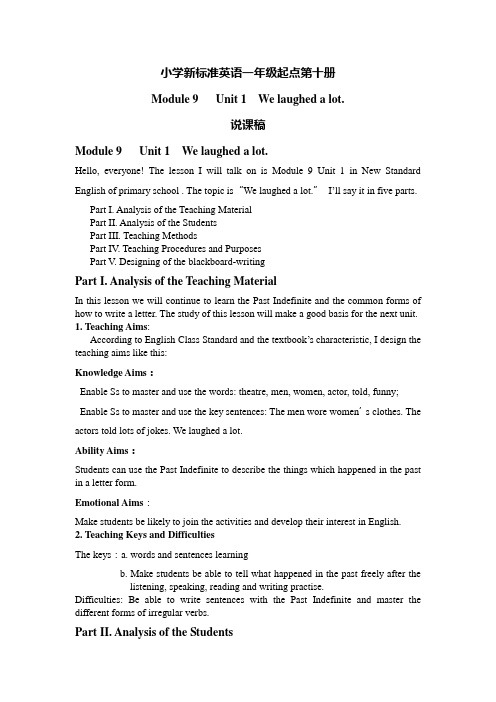
小学新标准英语一年级起点第十册Module 9 Unit 1 We laughed a lot.说课稿Module 9 Unit 1 We laughed a lot.Hello, everyone! The lesson I will talk on is Module 9 Unit 1 in New Standard English of primary school . The topic is“We laughed a lot.”I’ll say it in five parts.Part I. Analysis of the Teaching MaterialPart II. Analysis of the StudentsPart III. Teaching MethodsPart IV. Teaching Procedures and PurposesPart V. Designing of the blackboard-writingPart I. Analysis of the Teaching MaterialIn this lesson we will continue to learn the Past Indefinite and the common forms of how to write a letter. The study of this lesson will make a good basis for the next unit.1. Teaching Aims:According to English Class Standard and the textbook’s characteristic, I design the teaching aims like this:Knowledge Aims:Enable Ss to master and use the words: theatre, men, women, actor, told, funny; Enable Ss to master and use the key sentences: The men wore women’s clothes. The actors told lots of jokes. We laughed a lot.Ability Aims:Students can use the Past Indefinite to describe the things which happened in the past in a letter form.Emotional Aims:Make students be likely to join the activities and develop their interest in English.2. Teaching Keys and DifficultiesThe keys:a. words and sentences learningb. Make students be able to tell what happened in the past freely after thelistening, speaking, reading and writing practise.Difficulties: Be able to write sentences with the Past Indefinite and master the different forms of irregular verbs.Part II. Analysis of the StudentsThe study of this unit is to talk about the past events with The Simple Past Tense. The students have been studied the expression of The Simple Past Tense in Grade 4 .Therefore ,the main work of this lesson is to review ,consolidate ,improve and expand. The teacher should bring students’original knowledge store into play, motivate their interest ,create linguistic situation for the students, help students sortout knowledge and master in system.Part III. Teaching MethodsLanguage is inseparable from context. Therefore, besides the given scenarios in the textbook , I will bring task-based teaching method into play ,create linguistic situation which is close to their study, life for the students, Enable students to start thinking and imagination freely, make full use of linguistic knowledge ,cultivate their ability to communicate with others in English, to really use while learning and learn while using.Part IV. Teaching Procedure and PurposesI design the procedure with six steps.Step I WarmerStep II PresentationStep III Text--TeachingStep IV ConsolidationStep V SummaryStep VI HomeworkStep I. WarmerI’ll show students this picture. And ask “What’s this?”Maybe they’ll answer in English “It’s a theatre.”or in Chinese. By this way, I’ll teach the new word “theatre”. Then, I’ll ask students what’s the meaning of children’s theatre. ( Purpose: We will talk about the topic “children’s theatre”with this new word directly.)Step II PresentationTell students that Lingling went to a Children’s theatre last week. She was very happy. After the show she wrote a letter. Who did she write to? And after the show where did she go?(Purpose: Guide students into today’s lesson.)Step III Text--TeachingActivity 1Listen to the tape, look for the answers of these two questions.Q1: Who did Lingling write to?Q2: After the show where did Lingling go?(Purpose: Make students be familiar with the new lesson through these two questions and do some listening exercises.)Activity 2a. Let students open their books , read the text by themselves, and look for the answers of the third question: What did Lingling see in the theatre?(Purpose: This question is difficult for most students. So I won’t let students answer it at once after listening .I’ll arrange them to find the answers after reading the text by themselves. Meanwhile, it will improve their reading ability. )The answers of this question are the key sentences. So I’ll explain something and make some exercises.)b. Teach the words : men , women and their singular forms. Talk about women’s and men’s.c. Teach the words: actor and actress.d. Do some exercises to help students get initial master of the key sentences. Activity 3One of today’s tasks is to find the verbs in the past forms. So listen to the tape again, let students underline. And read out the sentences contain the verbs they found. Spell their original forms and observe the characteristics. Tell students that they’re irregular verbs. Meanwhile, review the four ways of the regular verbs and do an exercise. Activity 4Read the text after the tape. During the reading, I’ll explain some knowledge points. Activity 5a. Choose the correct answersb. Spell the correct answersStep IV ConsolidationActivity 1 An exercise of listening.Let students close their books, listen to the tape about Activity 2 in page 35. Let students hear out the key sentences. I’ll write these sentences on the blackboard. ( Purpose: One to have a consolidation of the key sentences. One to have a train of their ability of listening. And one to make a basis for the next activity.)Activity 2 An interesting descriptionI’ll show some interesting pictures, encourage students to use the key sentences to describe. Such as…(Purpose: Encourage students to use what they learnt in daily talking.)Activity 3 A guessing gameI’ll show the picture of Activity 3 in page 35. Let students guess what he did last night. I’ll show some verbs to help them. First let students change the verbs into their past forms. Then they guess, I’ll show the corresponding pictures.Activity 4 Another guessing gameLet students guess what I did last week.( Purpose: Create a scene again and this is about the teacher.This will make Ss feel funny and they’ll be interested in it.)Activity 5 An exercise of writingLet students help me write a letter to my friend to tell her what I did last week. They say, I’ll write on the blackboard.(Purpose: Cultivate their writing ability. )Step V SummaryEncourage students to have a summary. If their summary is not full, I will make it complete.Step VI HomeworkLet students write to their friends. Talk about what they did last week. (Purpose: The letter is just a carrier in this lesson. It leads students to talk about events with the Past Indefinite again, make teaching extend to after school and also extend to their lives.)Part V. Designing of blackboard-writingI divide the blackboard into three parts. I’ll write the knowledge points in part one. And key sentences, composition in part two. In part three, it’s for the comparison between the teams.。
小学英语 Unit 1 We laughed a lot.-一等奖
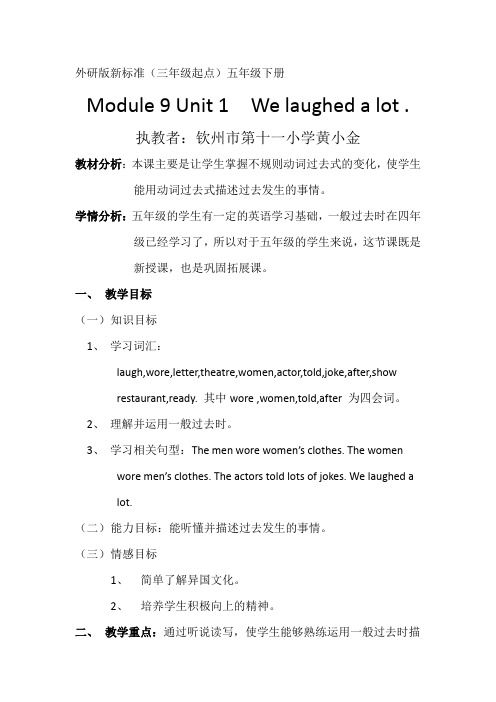
外研版新标准(三年级起点)五年级下册Module 9 Unit 1 We laughed a lot .执教者:钦州市第十一小学黄小金教材分析:本课主要是让学生掌握不规则动词过去式的变化,使学生能用动词过去式描述过去发生的事情。
学情分析:五年级的学生有一定的英语学习基础,一般过去时在四年级已经学习了,所以对于五年级的学生来说,这节课既是新授课,也是巩固拓展课。
一、教学目标(一)知识目标1、学习词汇:laugh,wore,letter,theatre,women,actor,told,joke,after,showrestaurant,ready. 其中wore ,women,told,after 为四会词。
2、理解并运用一般过去时。
3、学习相关句型:The men wore women’s clothes. The womenwore men’s clothes. The actors told lots of jokes. We laughed alot.(二)能力目标:能听懂并描述过去发生的事情。
(三)情感目标1、简单了解异国文化。
2、培养学生积极向上的精神。
二、教学重点:通过听说读写,使学生能够熟练运用一般过去时描述过去发生的事情。
三、教学难点:1、熟练掌握不规则动词过去式的变化,能用一般过去时正确书写语句。
2、单词theatre及restaurant 的准确发音。
四、教学手段和方法:多媒体辅助手段任务型、情景教学法。
五、教具:单词卡、PPT六、教学过程Step 1. RevisionRevise the past form of the irregular verbs.Step 2. Presentation1.( T: Let’s enjoy a video) Use the funny video to guidethe tittle. “We laughed a lot.”Learn the new word“laugh”2.T: Yesterday Amy,Sam and Lingling went to the park.They saw some funny things. Let’s have a look.Activity 1. Watch the video . Get the Ss read out.Learn the new word “wore” with the card.T: He wore a skirt. It’s a traditional men’s clothes inScotland.Step 3. Learn the textT: Amy,Sam and Lingling laughed a lot last week. Why? Let’s have a look.Activity 2. 1. Watch the video of Ph1. Get the Ss read out. Learnthe new word “ letter”.2.Watch the video of the letter and understand themain points.3. Watch the video again and answer the questions.1. Where did they go last week?( They went to a children’s theatre.)2.What did the men and the women wear?( The men wore women’s clothes.)(The women wore men’s clothes.)3.What did the actors do?(They told lots of jokes.)4.Where did they go after the show?(They went to a restaurant.)5.What did they eat?( They ate hamburgers and chips.)Learn the other new words with cards and picturesin this PPT.4.Get the Ss read out the letter.5.Do some exercises1. True or False2. Complete the textStep 4. Exercise and extension1.Show the pictures of Hua Mulan and Xiao Shenyang. Get the Ssanswer the questions.2.Show the photos of our school activities last year. Get the Ss describethem.Step 5. Emotional education1.Time for fun ( Watch a video of Charles Chaplin.)2.Give you a word( A smile can make you ten years younger. 笑一笑,十年少。
- 1、下载文档前请自行甄别文档内容的完整性,平台不提供额外的编辑、内容补充、找答案等附加服务。
- 2、"仅部分预览"的文档,不可在线预览部分如存在完整性等问题,可反馈申请退款(可完整预览的文档不适用该条件!)。
- 3、如文档侵犯您的权益,请联系客服反馈,我们会尽快为您处理(人工客服工作时间:9:00-18:30)。
前言:要想成为一名优秀的教师,不仅要对教材有所了解,还要对学生的情况有清晰明了的掌握,站在学生的角度思考问题,这样才能了解学生真正的学习需求,做到因材施教、有的放矢。
在教学过程中,学生是学习的主体,教师是学习的组织者,引导者,教学的一切活动都必须以强调学生的主动性,积极性为出发点。
《We laughed a lot》说课稿
(最新精品获奖说课稿)
Ⅰ. Teaching Objectives
Knowledge Aims: Students will be able to read, recognize, and use these words: wore, told, show, women, actor, joke, funny, after, theatre, ready; students can master the sentence pattern: The men wore women’s clothes. The actors told lots of jokes.
Ability Aims:
1. Through answering questions,pair works and group discussion, students can describe the past event with the above sentence pattern.
2. Their listening and speaking ability will have an improvement.
Emotional Aims: Students can develop independent learning ability and their team work spirit can be improved by working in groups.
Ⅱ. Key and difficult points
Key points: Students can master the simple past forms of irregular verbs.
Difficult points: Students can use the simple past forms of irregular verbs to describe the past event and their own life.
Ⅲ. Teaching procedures
Step One Warming-up and Revision
1. Greetings
2. Free talk。
